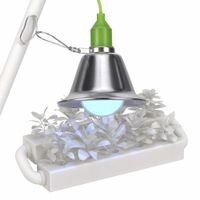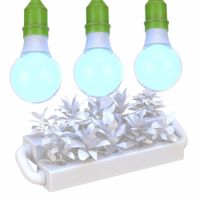Call +(254) 703 030 000 / 751 483 999 / 721 704 777
- Home
- Lighting
- Lighting Fixtures Retrofit Kits
- Grow Lights For Indoor Plants
- Grow Light Fixtures
Grow Light Fixtures
Grow light fixtures connect to an electrical system and use grow light bulbs or built-in LED arrays to grow plants indoors. They provide light in color spectrums that optimize seedling growth, stem and leaf growth, or budding and flowering. The fixtures are rated for wet locations to withstand high .....Read More
Frequently Asked Questions
What are the best grow lights for indoor plants?
The best grow lights for indoor plants depend on the specific needs of the plants, but generally, LED grow lights, fluorescent lights, and HID lights are popular choices.
1. **LED Grow Lights**: These are energy-efficient, long-lasting, and produce less heat, making them ideal for indoor gardening. They offer a full spectrum of light, which can be tailored to the specific growth stages of plants. Brands like Spider Farmer, Mars Hydro, and Viparspectra are well-regarded for their quality and performance.
2. **Fluorescent Lights**: These are cost-effective and suitable for small to medium-sized indoor gardens. T5 fluorescent lights are particularly popular due to their efficiency and ability to provide a balanced light spectrum. They are best for seedlings, herbs, and leafy greens.
3. **HID Lights (High-Intensity Discharge)**: These include Metal Halide (MH) and High-Pressure Sodium (HPS) lights. MH lights are good for vegetative growth due to their blue spectrum, while HPS lights are better for flowering stages with their red spectrum. They are powerful and suitable for larger setups but consume more energy and produce more heat.
4. **CFLs (Compact Fluorescent Lights)**: These are suitable for small spaces and are easy to set up. They are less intense than other options but can be effective for low-light plants or supplemental lighting.
When choosing grow lights, consider the light spectrum, energy efficiency, heat output, and the specific needs of your plants. Full-spectrum lights are generally the best choice as they mimic natural sunlight. Additionally, ensure the lights are adjustable in height and intensity to accommodate different growth stages.
How do I install grow lights in my home?
1. **Choose the Right Grow Lights**: Select the type of grow lights suitable for your plants. Options include LED, fluorescent, and HID lights. LEDs are energy-efficient and have a long lifespan.
2. **Determine Light Requirements**: Understand the light requirements of your plants. Some need full-spectrum light, while others may require specific wavelengths.
3. **Select Location**: Choose a location with access to power outlets and adequate space for your plants. Ensure the area can handle the heat output from the lights.
4. **Install Fixtures**: Securely mount the light fixtures. For overhead lighting, use hooks or brackets to hang the lights. Ensure they are adjustable to change the height as plants grow.
5. **Position Lights**: Place the lights at the correct distance from the plants. Generally, LEDs should be 12-24 inches above, while fluorescents can be closer.
6. **Set a Timer**: Use a timer to automate the light cycle. Most plants require 12-16 hours of light per day. Adjust based on plant type and growth stage.
7. **Ensure Proper Ventilation**: Install fans or ensure good airflow to prevent overheating and promote healthy plant growth.
8. **Monitor and Adjust**: Regularly check plant health and adjust light intensity and duration as needed. Look for signs of too much or too little light, such as leaf discoloration.
9. **Safety Precautions**: Ensure all electrical connections are secure and protected from water. Use surge protectors and avoid overloading circuits.
10. **Maintenance**: Clean the lights regularly to maintain efficiency and replace bulbs as needed. Check for any wear and tear on fixtures and wiring.
What is the difference between LED and fluorescent grow lights?
LED grow lights use light-emitting diodes to produce light, offering high energy efficiency, longer lifespan, and customizable light spectrums. They generate less heat, reducing the need for additional cooling systems and allowing closer placement to plants without risk of burning. LEDs are more expensive upfront but save money over time due to lower energy consumption and maintenance costs.
Fluorescent grow lights, such as T5, T8, and compact fluorescent lamps (CFLs), use gas-discharge technology to produce light. They are generally less expensive initially and provide a broad light spectrum suitable for various plant growth stages. However, they are less energy-efficient than LEDs and have a shorter lifespan. Fluorescents emit more heat, requiring careful distance management to prevent plant damage and may necessitate additional cooling.
In summary, LEDs offer efficiency, longevity, and spectrum control, while fluorescents are cost-effective initially but less efficient and durable.
How long should grow lights be on each day?
The duration for which grow lights should be on each day depends on the type of plants being grown and their specific light requirements. Generally, plants are categorized into three groups based on their photoperiod needs: short-day, long-day, and day-neutral plants.
1. **Short-Day Plants**: These plants require longer periods of darkness and shorter periods of light to flower. Examples include chrysanthemums and poinsettias. For these plants, grow lights should typically be on for about 8 to 12 hours per day.
2. **Long-Day Plants**: These plants need longer periods of light to trigger flowering. Examples include lettuce and spinach. For long-day plants, grow lights should be on for about 14 to 18 hours per day.
3. **Day-Neutral Plants**: These plants are not sensitive to the length of the light period for flowering. Examples include tomatoes and peppers. For day-neutral plants, a consistent 12 to 16 hours of light per day is usually sufficient.
In addition to the type of plant, the growth stage also influences light duration:
- **Seedlings**: Young plants generally require more light to support rapid growth. Providing 16 to 18 hours of light per day is common.
- **Vegetative Stage**: During this stage, plants benefit from 14 to 18 hours of light to promote strong, healthy growth.
- **Flowering Stage**: Depending on the plant type, the light duration may need adjustment. Short-day plants may require reduced light, while long-day plants may continue with extended light periods.
It's important to mimic natural light cycles as closely as possible and ensure a period of darkness to allow plants to rest. Using timers can help maintain consistent light schedules.
Can grow lights replace sunlight for plants?
Yes, grow lights can replace sunlight for plants, but with certain considerations. Grow lights are designed to mimic the natural light spectrum that plants need for photosynthesis, which includes red and blue wavelengths. These lights can be used to provide the necessary light for plant growth, especially in indoor or low-light environments.
Different types of grow lights, such as LED, fluorescent, and HID, offer varying efficiencies and spectrums. LED grow lights are particularly popular due to their energy efficiency, long lifespan, and ability to provide a full spectrum of light. They can be tailored to emit specific wavelengths that are most beneficial for plant growth, such as blue light for vegetative growth and red light for flowering.
However, while grow lights can effectively replace sunlight, they must be used correctly to ensure optimal plant health. This includes providing the right intensity, duration, and spectrum of light. Plants require different amounts of light depending on their species and growth stage. For instance, seedlings need less intense light compared to mature plants.
Moreover, grow lights do not provide the full range of benefits that sunlight offers. Sunlight includes ultraviolet (UV) and infrared (IR) light, which can have additional effects on plant health and growth. While some grow lights include UV and IR, they may not fully replicate the natural conditions provided by sunlight.
In conclusion, grow lights can effectively replace sunlight for plant growth, especially in controlled environments. However, careful management of light intensity, duration, and spectrum is crucial to ensure plants receive the necessary conditions for healthy growth.
What color spectrum is best for plant growth?
The best color spectrum for plant growth primarily includes blue and red wavelengths. Blue light, typically in the range of 400-500 nanometers, is crucial for vegetative growth as it influences chlorophyll production, which is essential for photosynthesis. It helps in the development of strong stems and healthy leaves. Red light, in the range of 600-700 nanometers, is vital for flowering and fruiting stages. It promotes flowering and budding by influencing phytochrome, a plant pigment that regulates growth and development.
While blue and red lights are the most critical, a full spectrum that includes other wavelengths can also be beneficial. Green light (500-600 nanometers), although less efficiently absorbed by chlorophyll, penetrates deeper into the leaf structure and can enhance photosynthesis in lower leaf layers. Far-red light (700-750 nanometers) can influence plant morphology and flowering by affecting the phytochrome system.
Using a combination of these wavelengths, often referred to as a full-spectrum light, can mimic natural sunlight and support all stages of plant growth. LED grow lights are popular for this purpose as they can be tailored to emit specific wavelengths and are energy-efficient. Balancing the spectrum according to the plant's growth stage can optimize growth, yield, and overall health.
How do I choose the right grow light for my plants?
1. **Plant Type**: Determine the specific light requirements of your plants. Some plants need full-spectrum light, while others may thrive under specific wavelengths.
2. **Light Spectrum**: Choose a grow light that offers the appropriate spectrum. Full-spectrum lights mimic natural sunlight and are suitable for most plants. Red and blue lights are often used for specific growth stages.
3. **Light Intensity**: Consider the light intensity needed. High-light plants like tomatoes require more intense light compared to low-light plants like ferns.
4. **Coverage Area**: Measure the area you need to cover. Ensure the grow light can adequately cover your plants without leaving gaps.
5. **Energy Efficiency**: Look for energy-efficient options like LED grow lights, which consume less power and have a longer lifespan compared to traditional lights.
6. **Heat Output**: Consider the heat output of the grow light. LEDs produce less heat, reducing the risk of burning plants and the need for additional cooling.
7. **Adjustability**: Opt for lights with adjustable settings for intensity and spectrum to accommodate different growth stages and plant types.
8. **Budget**: Determine your budget. While LEDs may have a higher upfront cost, they save money in the long run due to energy efficiency and longevity.
9. **Installation and Space**: Ensure the grow light fits your space and is easy to install. Consider the height and distance from plants for optimal light distribution.
10. **Brand and Reviews**: Research brands and read reviews to ensure reliability and performance. Choose reputable brands with good customer support.
11. **Timer and Automation**: Consider lights with built-in timers or compatibility with smart home systems for automated light cycles.


